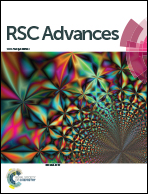Lewis acid type deep eutectic solvents as catalysts for epoxy resin crosslinking
Abstract
The curing process of epoxy resin with deep eutectic solvents (DES), composed of choline chloride and ZnCl2 or SnCl2, as cationic catalysts has been investigated using rheometry, DSC and FTIR techniques. The differences between two DES types in the catalytic activity towards epoxy resin were discussed based on the pot life at room temperature evaluation, as well as onset temperatures and temperatures at maximum of DSC exotherms, as a function of DES/epoxy resin weight ratio. Moreover, a curing mechanism was proposed. Thermomechanical properties (glass transition temperature, tan δ), crosslink density, thermal resistance as well as the flammability of cured epoxy materials were determined.


 Please wait while we load your content...
Please wait while we load your content...